The Power of a Digital Presence: How Diverse Publisher Coverage Impacts Brand Discoverability
The Power of a Digital Presence: How Diverse Publisher Coverage Impacts Brand Discoverability
Research from Yext shows brands can see +186% more clicks from Google when they manage their information across an extended publisher network. More frequent data updates matter, too.

For years, ranking in the top results on Google has been the cornerstone of an effective SEO strategy. With less than 1% of customers referencing the second page of results, brands must be present to perform. Traditionally, achieving this meant focusing on a Google-centric keyword strategy and managing brand information across a few select major publishers (e.g. Google, Apple, Facebook, Bing, etc.).
But the search landscape is evolving, and customer behavior is shifting with a desire for clear and concise answers. Search engines are refining their algorithms with AI-led technology, seeking information from a variety of sources. Winning in organic search now requires brands to improve their signal to Google through a robust digital presence, with coverage across an extended network of publishers to boost their relevancy and accuracy (among other factors).
But how many publishers should a brand prioritize? The answer is more than you might think.
New research from Yext reveals that brands limiting their information management to only a few major publishers see lower overall web performance from Google. The data, based on 620K+ locations managed within the Yext platform, shows that brands who appear across >75% of publishers in the Yext network measure a +186% increase in clicks to their websites from Google compared to those appearing on fewer publishers.
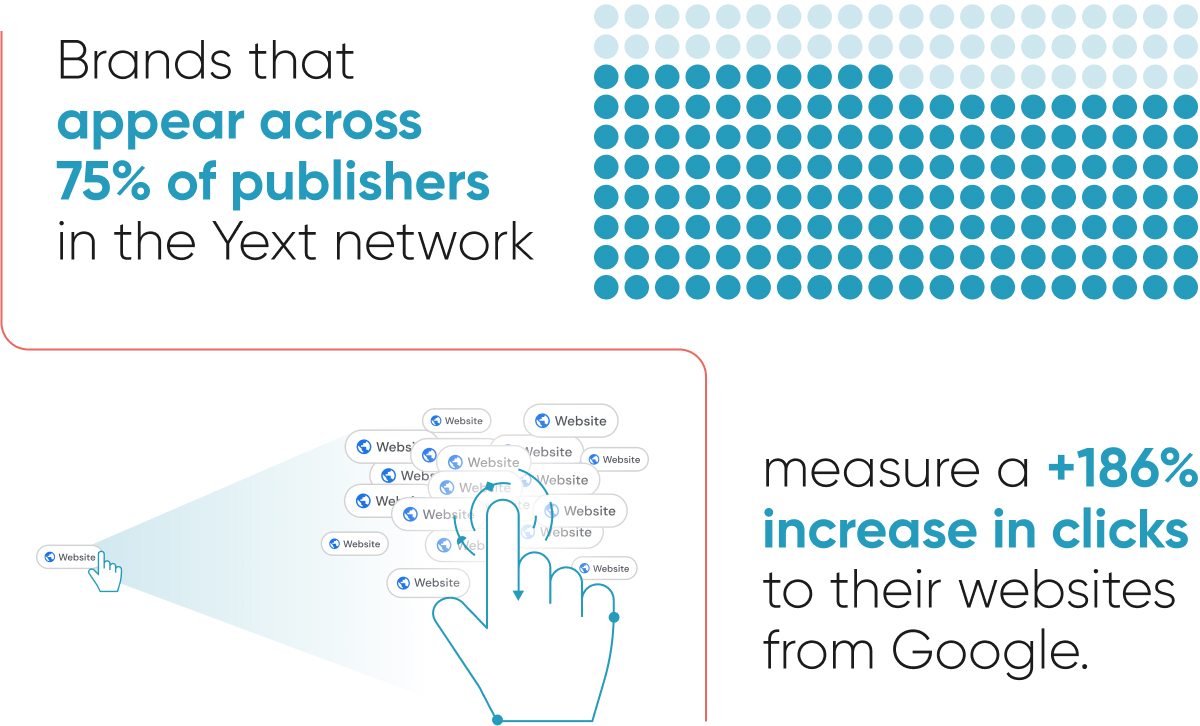
What does this mean? Data accuracy, freshness, and consistency across an extended network will continue to be pivotal for brand discoverability and customer conversion as search evolves. How brands prepare today will prevent missed opportunities tomorrow.
The following outlines how brands can:
- Take immediate action to optimize brand performance on Google
- Expand their SEO strategy to prepare for AI-led technologies (like SGE and ChatGPT)
- Grow their digital presence to increase brand discoverability in a fragmented search landscape
Extended publisher network impact on Google discoverability
 Yext analyzed global data across 620K+ locations and major industries (including healthcare, financial services, retail, restaurants, hospitality, and more) to determine the value of a broad digital presence beyond only major publishers like Google, Bing, Apple, etc.
Yext analyzed global data across 620K+ locations and major industries (including healthcare, financial services, retail, restaurants, hospitality, and more) to determine the value of a broad digital presence beyond only major publishers like Google, Bing, Apple, etc.
The main takeaway? A brand with correct and consistent information across the most publishers in their market will beat those who only focus on a few of the biggest ones. Harnessing the power of consistent data accuracy across a diverse network of publishers correlates directly to more clicks on Google, delivering better results for brands.
Our research found:
- Locations with less than 50% of the network synced saw the least amount of Google website traffic. This number served as the baseline for the average percent increases in Google website clicks for the other two ranges.
- Locations syncing between 50%-75% of the network received a substantial bump in Google website clicks, with an average increase of +95% over the first group.
- Locations syncing more than 75% of the network saw even better results, with a stunning average increase of +186% in Google website clicks.
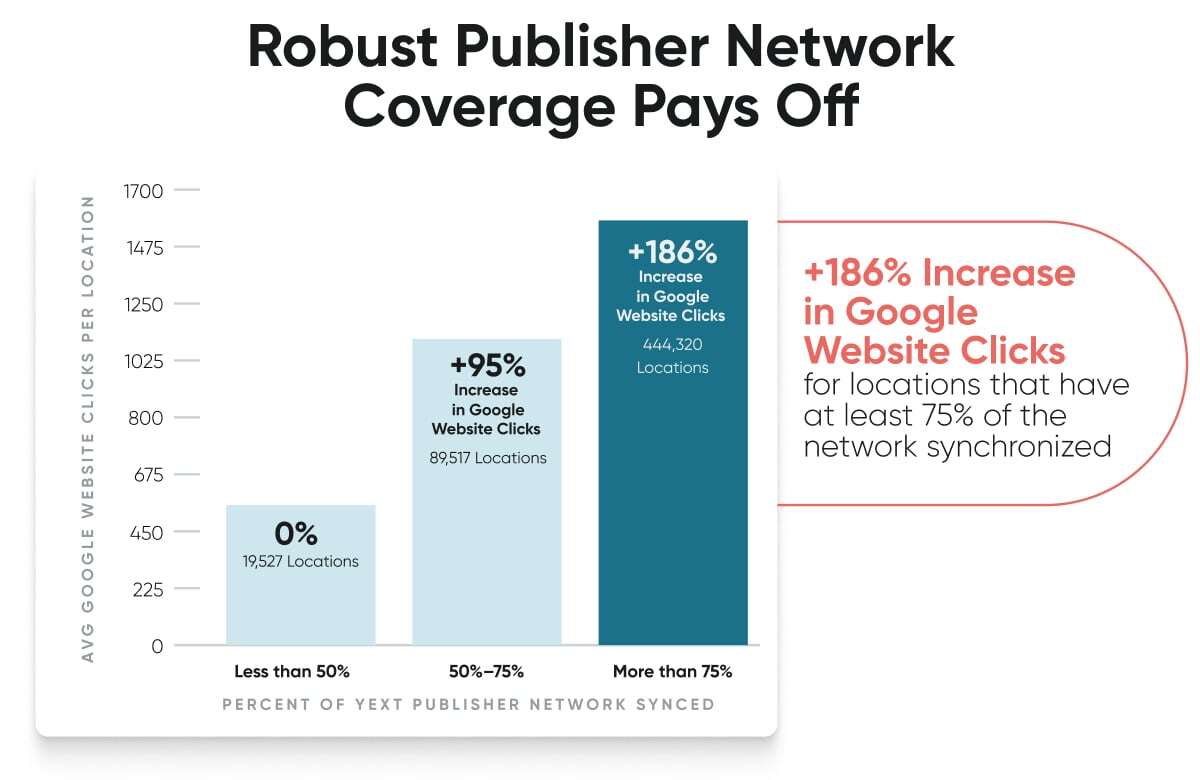
To go deeper into the data, here's what that looks like with each circle representing an individual location:
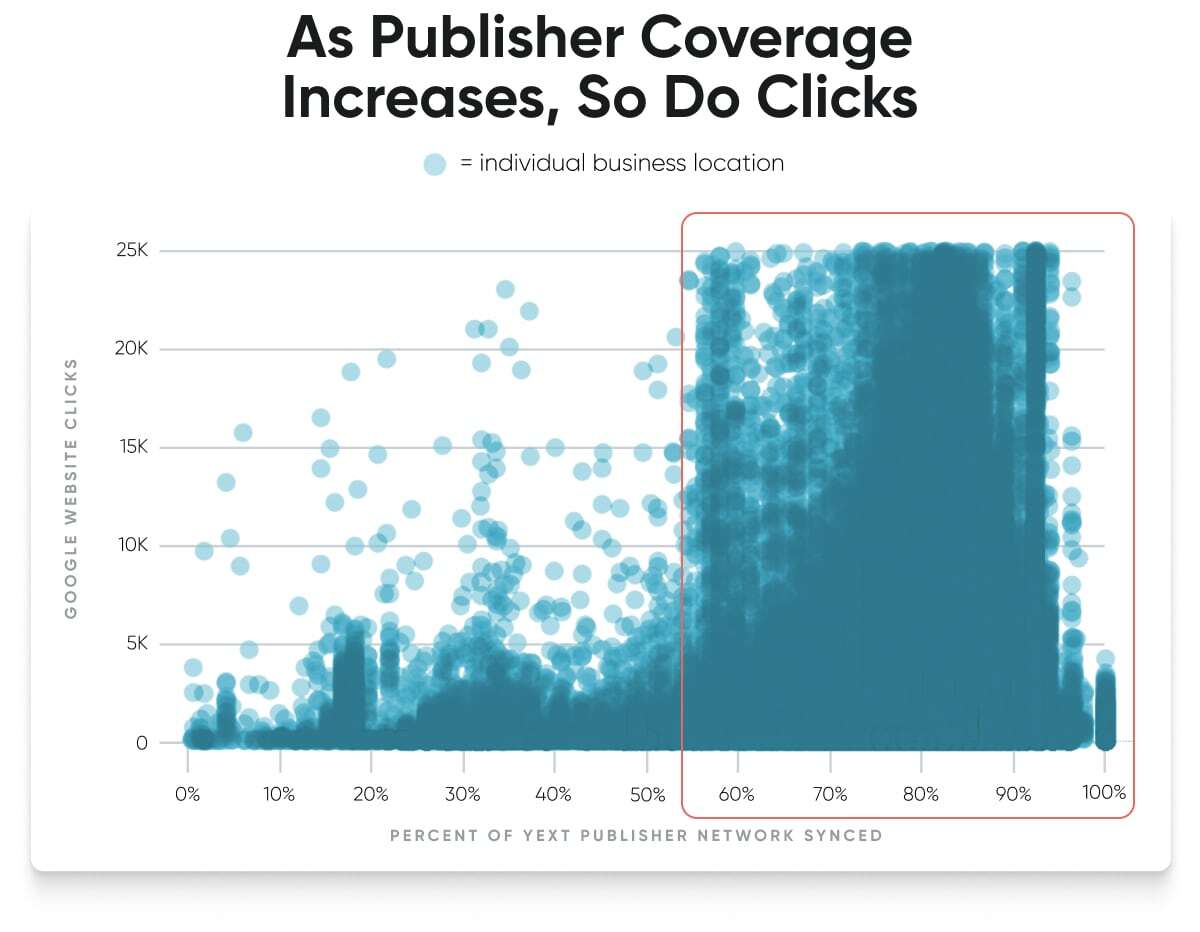
The data holds up across industries. Take a look at the following highlights for enterprise brands who are synchronized across more than 75% of the publisher network.
- Food: An average 65% increase in Google website clicks
- Healthcare: An average 50% increase in Google website clicks
- Retail: An average 44% increase in Google website clicks
- Financial Services: An average 91% increase in Google website clicks

Why does consistent information across a large publisher network correlate to Google website clicks?
Prominent search engines look at how brand information is consistently shown across many publishers to help determine their rankings and recommendations.
Presenting consistent information everywhere that search engines and AI tools gather information helps increase confidence in that information. If a brand has less information available online, or worse, it's inconsistent, these systems can't know if the brand information is correct. They want their customers to receive accurate answers, so brands with more proof points to pull from are prioritized.
When we asked Google's Gemini, "why does having a consistent digital presence on more publishers result in more Google website clicks?" — the answer confirmed our findings.
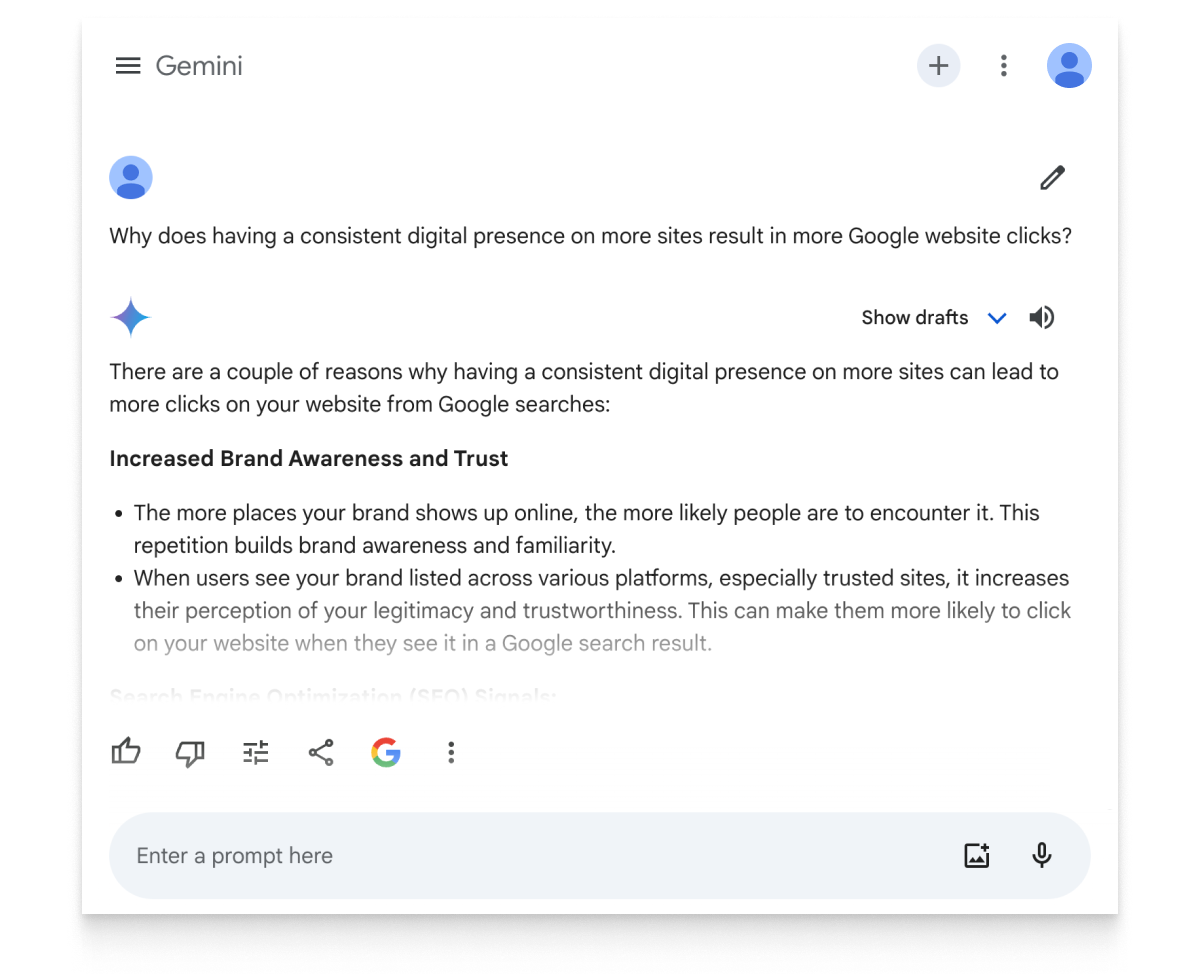
Try it yourself on both Google Gemini and OpenAI's ChatGPT.
This result suggests why claims that brands only need to manage their information across a few major publishers (Google, Bing, Apple, and Facebook) aren't true. We'll dig deeper into why in the generative AI section below.

Is consistency the only factor that matters for discoverability?
Consistent and correct information across a wide publisher network is the foundation of any brand’s digital presence. But it isn’t the only ranking factor that matters. Our research shows that how frequently brands update their information plays a key role in building algorithmic trust with search engines and AI models.
Why? Updated information signals to the customer – and search engines – that a brand is active and relevant. Think of it this way: a customer is more likely to trust a store’s hours if they were recently updated, versus one that hasn’t been updated in five years. On the most basic level, search engines and AI models “think” the same way.
What’s the value of frequent updates? We found that every 1% increase in update frequency can lead to about a 2.23% boost in Google clicks to a brand’s website. For example, a location with 10,000 annual website visits from Google could gain an additional 2,000 visits by increasing monthly updates from 10 to 11 on the Yext platform.
By balancing data consistency with timely updates, brands are better positioned to surface in search experiences.
*An important note: updates that don’t occur in real-time tend to cause inconsistencies in data across platforms. It’s critical to never make updates that sacrifice your data consistency. You need both, and you should work with platforms that maintain both.
Finally: do data aggregators have the same impact?
Data aggregators aren't the answer for a brand to surface consistent information. It's a common claim that aggregators can improve coverage. But in reality, they can do more harm than good when they are used as the primary source to achieve network synchronization.

Here are a few reasons why:
- Data Inconsistencies: Aggregators gather information about brands from various sources, including public records, online directories, and other providers. This can lead to inconsistencies if brand information changes or if there are errors in the aggregated information.
- Delayed Updates: Updates to brand information (like address, phone number, or hours of operation) may not immediately reflect across all platforms that receive information from a data aggregator. This delay can lead to inconsistencies in how information is represented across publishers.
- Lack of Direct Control: Data aggregators submit information to multiple publishers, but there isn't clear visibility into which publishers it sends to — or when. This means zero control or visibility into which publishers data will update on.
- Listings Reversion Risk: Should you discontinue your relationship with an aggregator solution, listings will likely revert to their previous state as stated by the data aggregators' terms of use.
- No say in which data gets used: Working with data aggregators can certainly help get brand data out in more places, but the problem is that every client (publisher) buying the data from a data aggregator gets to choose what data they use. This means if one publisher only buys the name, address, and phone number (NAP), and a different publisher buys the NAP and hours of operation, the brand has no idea what is actually being used where. This makes it impossible to have consistent data everywhere.
Simply put, data aggregators do not provide true and lasting synchronization across the extended publisher network with consistent and timely information.
Looking ahead: SEO & Generative AI
 Search is competitive — and it's only becoming more complex with the introduction of generative AI. Customers are seeking direct answers, and a brand's differentiator is their ability to show up with accurate information.
Search is competitive — and it's only becoming more complex with the introduction of generative AI. Customers are seeking direct answers, and a brand's differentiator is their ability to show up with accurate information.

Traditional search engines like Google are already incorporating generative AI through additional sections like Search Generative Experience (SGE), which uses AI to generate a direct response to a search query.
Across the board, AI models like ChatGPT and Gemini are reshaping search — with Gartner predicting a 25% drop in search volume as customers move to chatbots and virtual agents to answer their questions.
These technologies use a variety of data sources to pull and collect information when they generate answers - including smaller publishers.
When ChatGPT is prompted to cite its sources after providing an answer about a local financial representative, it doesn't reference information from big publishers like Google, Facebook, Bing, or Apple. Instead, it cites source data from Yp.com and Localmint:
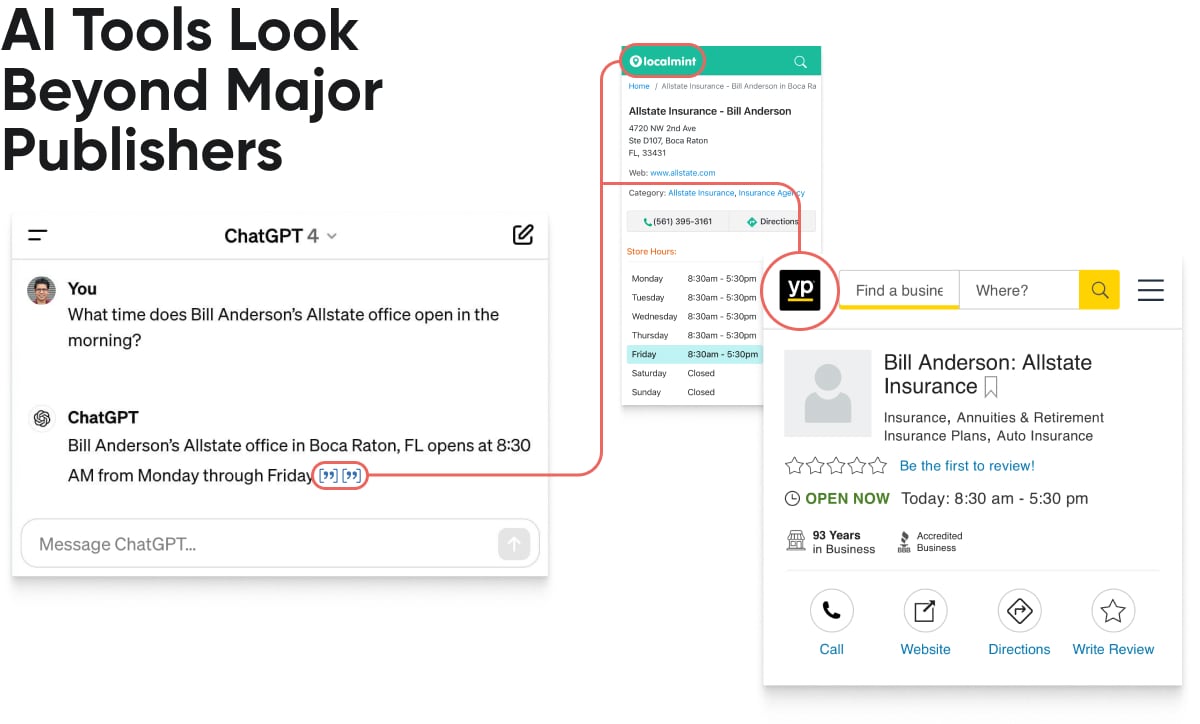
If brands aren't actively managing their information broadly and consistently, AI-led models like Gemini or ChatGPT - and soon-to-be others - could present people with inaccurate information following a query, or, worse, not surface information about them at all.
Brand discoverability in a fragmented search landscape
 Today, most brands are still heavily focused on driving traffic from Google, which makes sense: at least 83% of customers look for information there before visiting a brand location.
Today, most brands are still heavily focused on driving traffic from Google, which makes sense: at least 83% of customers look for information there before visiting a brand location.
But as search evolves and customer behavior changes, syncing information to an extended network of publishers is important far beyond Google. It sets brands up to win in an increasingly fragmented search landscape.

What do we mean by "fragmented search landscape"? With so many search interfaces — including technologies like AI, voice search, and social media — there is no long-term guarantee that the customer journey will always start with a search on Google.
Beyond Gartner's prediction about AI chatbots and other virtual agents taking search share of voice, social media search is also on the rise. According to Google, nearly 40% of Gen Z may prefer searching on TikTok and Instagram over Google Search and Maps. In Europe, brands are already noticing a decline in Google traffic due to the implementation of the Digital Markets Act — making other publishers more important.
No matter where a brand operates, non-Google publishers might already matter more than you think: the typical location sees over 17% of all their digital engagement (including website traffic and detailed profile views) come from non-Google publishers.
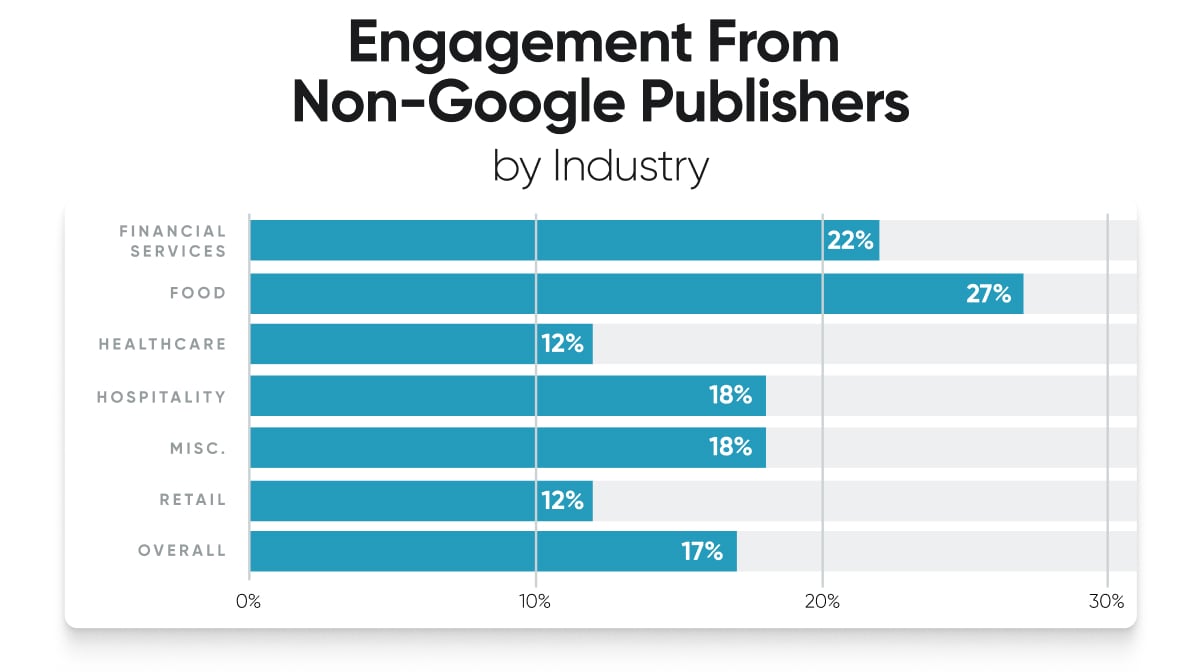
No one knows exactly how search might evolve over the next three to five years. But managing your brand's knowledge and truth is the best way to prepare for these inevitable changes in the customer journey. Consistent information — widely published across third-party publishers — offers search and AI the strong signals they need to trust your brand over your competition.
Conclusion
The digital landscape is rapidly changing as search engines evolve their algorithms, AI-driven experiences take hold, and social media platforms emerge as non-traditional search channels.
Customers are seeking answers everywhere, and those answers are being found by search and AI tools from many sources. That's why a brand's ability to increase discoverability and engage with customers depends on their digital presence's strength and accuracy beyond major platforms. Successful brands can remove the guesswork of what will come next by investing in a scalable solution to surface their information everywhere.

Brands with >75% coverage across the Yext network are already measuring better results (+186% better) compared to brands limiting their publishers. To drive more traffic via Google today and prepare for the future of search, brands should get started with a listings solution that provides consistent synchronization across the largest number of third-party publishers.
Yext is at the forefront of this transformation, with an industry-leading approach to information management that provides brands with a seamless digital presence across all channels regardless of what engine or tool customers use. With Yext, brands are best positioned to stay ahead of digital changes and deliver results without missing opportunities for their business.
* It’s important to note that while the correlation is strong and statistically significant, causation cannot be definitively claimed due to the complex nature of Google's algorithm.
Study Details
As the largest listings vendor, Yext helps thousands of multi-location brands manage their digital presence. This offers Yext the unique ability to conduct a study of this caliber using such a diverse and large data set. To take an unbiased approach, Yext analyzed more than 620k locations — across all geographies and brand types — that have been live on Listings for at least one year.
Every location examined was given a percentage of the listings network that they were eligible to be live on (e.g. UberEats only supports restaurants, so non-restaurant brands would be ineligible to sync data to UberEats). Although Yext always syncs brand information to all eligible publishers in our network, there are a few instances where a listing may not go live on a third-party publisher. For example, some brands choose to opt out of a given publisher and not sync data through Yext, or they never fill out a required field that's needed to make a listing go live.
This allowed Yext to examine if there's a correlation between the percentage of publishers a listing is eligible to sync to (RON%) and digital performance. In essence, does syncing to more third-party publishers help brands perform better on Google? For this study, we measured Google Website Clicks. Unlike passive metrics like impressions, website clicks from Google indicate the highest level of customer engagement and provide the best chance of conversion across the broadest set of brand types.


